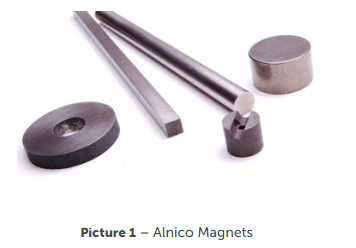Alnico is the name for an iron alloy that primarily consists of iron, aluminum (Al), nickel (Ni), and cobalt (Co). That is why it is called al-ni-co. It can also be spelled AlNiCo. Sometimes, it may also contain copper and titanium. Alnico alloys are used as permanent magnets, as they are ferromagnetic.
Alnico Magnetism
Alnico alloys were considered to be the strongest kind of magnets before rare earth magnets were developed in the 1970s. Alnico alloys have ferromagnetic properties which makes it strong permanent magnets. They are listed as some of the best permanent magnets for over fifty years now. Alnico alloys can also be magnetized to create strong magnetic fields. These magnets also show excellent stability in a wide range of temperatures. Alnico magnets can be effective in temperatures up to 1000°F.
Alnico Composition
The general composition of Alnico alloys is Al- 8-12%, Ni- 15-26%, and Co- 5-24%. It may also contain up to 6% copper (Cu), and up to 1% titanium (Ti). Depending on the percentage of the different components, there can be various different types of Alnico alloys.
Types of Alnico
Based on the process of preparation, and the different uses, Alnico alloys can be classified into three main types.
- Cast Alnico
- Sintered Alnico
- Bar Alnico
Development of Alnico
The development of Alnico began in Japan in 1931. T. Mishima was the first person to discover an alloy of aluminum, nickel, and cobalt that had high ferromagnetism. The first Alnico alloy had a ferromagnetism of 400 Oe (oersted- unit for magnetizing field). It was double of the magnetic field strength of the best magnet steels in existence at the time.
Preparation of Alnico
Generally, Alnico magnets are prepared in the metallurgic pressing-sintering process or casting process. The right heat treatment is very important in the process of the preparation of Alnico for the product to have the desired magnetic properties. If the applied heat is not right, the product will have the coercivity equal to that of iron, which is 10 Oe.
The process of preparing the Alnico alloys consists of heating at a critical temperature and then cooling in the presence of a strong magnetic field. First, all the raw materials are mixed together before the heating process starts. After the iron, aluminum, nickel, cobalt, and all the other components have been added in the right proportions, a liquefier is added. An external magnetic field is applied to it to orient the Alnico’s anisotropy in the desired magnetic axis. It is done during the precipitate particle nucleation (during cooling down from 900 °C to 800 °C).
Properties of Alnico
- All Alnico alloys have strong magnetic properties and high ferromagnetism.
- Alnico alloys are the only magnets to have useful magnetic powers at red hot temperature (500°C – 800°C).
- Alnico magnets have some of the highest curie points among all the magnetic materials. It ranges around 800°C.
- Unlike ceramic magnets, Alnico magnets have the property of electric conductivity.
- Alnico alloys have very good resistance to corrosion.
- Some Alnico alloys can have isotropic properties while others can have anisotropic properties.
Uses of Alnico
- Alnico alloys are used as strong permanent magnets.
- Alnico alloys can deliver good flux density at very economical prices.
- Alnico alloys are used to manufacture Microphones, electric guitar pickups, electric motors, loudspeakers, traveling-wave tubes, Hall Effect sensors, etc.
- Alnico speakers are the favorite of many musicians as they are known to produce the best tone, and they also respond quickly. Alnico speakers are the best for jazz, blues, and mellow rock.
Because of their high magnetic properties, Alnico alloys have many important uses in industrial functioning. From electric motors to guitar pickups to cow magnets – alnico alloys have diverse usefulness. Alnico magnets are a reliable answer whenever strong permanent magnets are needed.






0 Comments